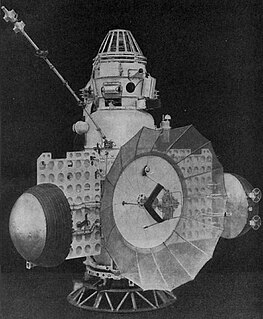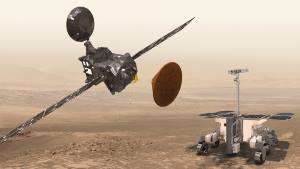
A spacecraft is a vehicle or machine designed to fly in outer space. Spacecraft are used for a variety of purposes, including communications, Earth observation, meteorology, navigation, space colonization, planetary exploration, and transportation of humans and cargo. All spacecraft except single-stage-to-orbit vehicles cannot get into space on their own, and require a launch vehicle.

A lander is a spacecraft which descends toward and comes to rest on the surface of an astronomical body. By contrast with an impact probe, which makes a hard landing and is damaged or destroyed so ceases to function after reaching the surface, a lander makes a soft landing after which the probe remains functional.

The planet Mars has been explored remotely by spacecraft. Probes sent from Earth, beginning in the late 20th century, have yielded a large increase in knowledge about the Martian system, focused primarily on understanding its geology and habitability potential. Engineering interplanetary journeys is complicated and the exploration of Mars has experienced a high failure rate, especially the early attempts. Roughly sixty percent of all spacecraft destined for Mars failed before completing their missions and some failed before their observations could begin. Some missions have met with unexpected success, such as the twin Mars Exploration Rovers, which operated for years beyond their specification.

Zond 2 was a Soviet space probe, a member of the Zond program, and was the fifth Soviet spacecraft to attempt a flyby of Mars. It was launched on 30th November 1964 at 13:12 UTC onboard Molniya 8K78 launch vehicle from Baikonur Cosmodrome, Kazakhstan, Russia. The spacecraft intended to survey Mars from its flight path but lost its communication before reaching Mars. It was sixth attempt of Soviet Union in direction towards Mars.

ExoMars is a two-part astrobiology project to search for evidence of life on Mars, a joint mission of the European Space Agency (ESA) and the Russian space agency Roscosmos. The first part, launched in 2016, placed the ExoMars Trace Gas Orbiter into Mars orbit and released the Schiaparelli EDM lander. The second part is planned to launch in 2020 and to land the Rosalind Franklin rover on the surface, supporting a science mission that is expected to last into 2022 or beyond.

Fobos-Grunt or Phobos-Grunt was an attempted Russian sample return mission to Phobos, one of the moons of Mars. Fobos-Grunt also carried the Chinese Mars orbiter Yinghuo-1 and the tiny Living Interplanetary Flight Experiment funded by the Planetary Society.

A Mars sample-return mission (MSR) would be a spaceflight mission to collect rock and dust samples on Mars and then return them to Earth. Sample-return would be a very powerful type of exploration, because analysis is freed from the time, budget, and space constraints of spacecraft sensors.

A human mission to Mars has been the subject of science fiction, aerospace engineering, and scientific proposals since the 19th century. The plans comprise proposals to land on Mars, eventually settling on and terraforming the planet, while utilizing its moons, Phobos and Deimos.

The ExoMars Trace Gas Orbiter is a collaborative project between the European Space Agency (ESA) and Roscosmos that sent an atmospheric research orbiter and the Schiaparelli demonstration lander to Mars in 2016 as part of the European-led ExoMars programme.

The National Aeronautics and Space Administration is an independent agency of the United States Federal Government responsible for the civilian space program, as well as aeronautics and aerospace research.

Mars 1M No.1, designated Mars 1960A by NASA analysts and dubbed Marsnik 1 by the Western media, was the first spacecraft launched as part of the Soviet Union's Mars programme. A Mars 1M spacecraft, it was intended for conducting flight testing system and to study the interplanetary environment between Earth and Mars, however it was lost in a launch failure before it could begin its mission.

Rosalind Franklin, previously known as the ExoMars rover, is a planned robotic Mars rover, part of the international ExoMars programme led by the European Space Agency and the Russian Roscosmos State Corporation.
Mars-Grunt, also known as Expedition-M, is a robotic spacecraft sample return mission proposed to be sent to Mars in mid-2020s. It was proposed to the Russian Federal Space Agency (Roscosmos) by the Russian Space Research Institute.

The Mars Global Remote Sensing Orbiter and Small Rover (HX-1) is a planned project by China to deploy an orbiter and rover on Mars. The mission is planned to be launched in July or August 2020 with a Long March 5 heavy lift rocket. Its stated objective is to search for evidence of both current and past life, and assessing the planet's environment.
The ExoMars Kazachok is a planned robotic Mars lander led by the Roscosmos, part of the ExoMars 2020 mission by the Roscosmos and the European Space Agency. Kazachok translates as "Little Cossack", and is also the name of a Russian folk dance.

This article documents expected notable spaceflight events during the 2020s.

This article documents expected notable spaceflight events during the year 2022.
The Fine-Resolution Epithermal Neutron Detector (FREND) is a neutron detector that is part of the instrument payload on board the ExoMars Trace Gas Orbiter (TGO), launched to Mars in March 2016. This instrument is currently mapping hydrogen levels to a maximum depth of 1 m beneath the Martian surface, thus revealing shallow water ice distribution.This instrument has an improved resolution of 7.5 times over the one Russia contributed to NASA's Mars Odyssey orbiter.


















